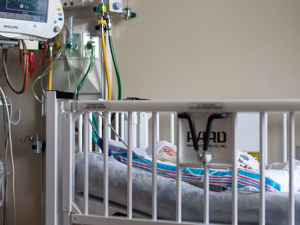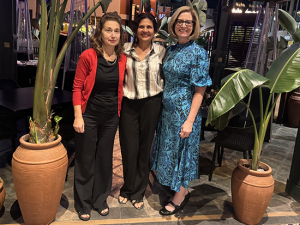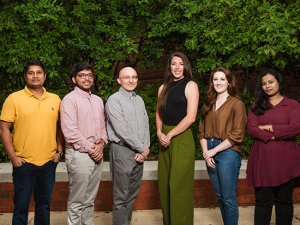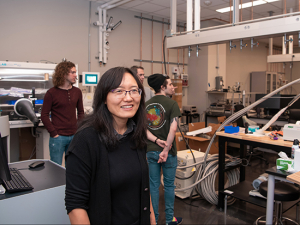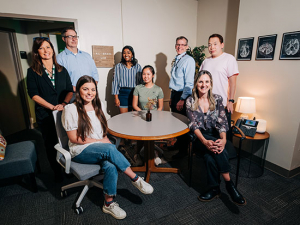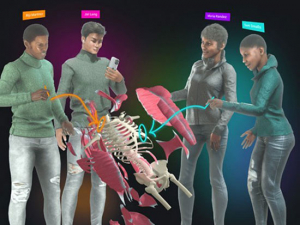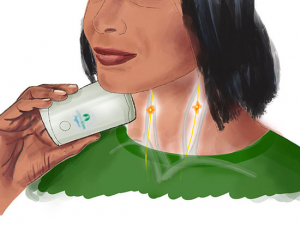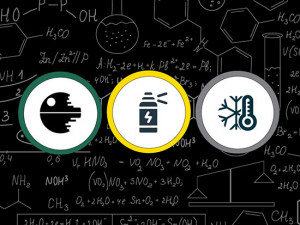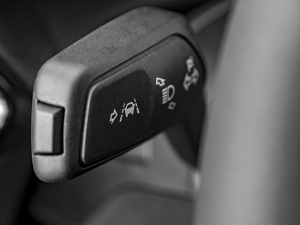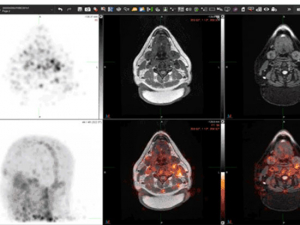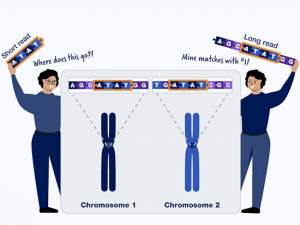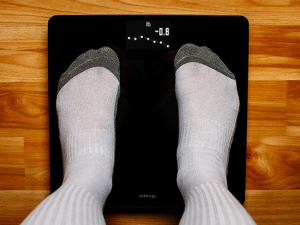 If you’ve been strolling through, or by, the Hugh Kaul Human Genetics Building lately, you may have noticed a colorful digital sign that has appeared opposite the building’s front door. It’s the scrolling variety often used for news flashes and stock tickers. This one seems to be sharing some kind of code.
If you’ve been strolling through, or by, the Hugh Kaul Human Genetics Building lately, you may have noticed a colorful digital sign that has appeared opposite the building’s front door. It’s the scrolling variety often used for news flashes and stock tickers. This one seems to be sharing some kind of code.
AP4M1 APT1A3…. BRAF BTK C12orf57… GMPPA GPR109B HDAC8 HECW…
They are, in fact, genes. Wait long enough, and you can read a message in smaller type below:
Welcome to the Precision Medicine Institute! We are looking for expertise in these genes. Please email or knock on glass.
The sign is the work of Matt Might, Ph.D., director of UAB’s Hugh Kaul Precision Medicine Institute, which focuses on advancing new approaches for prevention, diagnosis and treatment of disease tailored to the individual patient.
Often, that work leads PMI researchers to specific genes that seem to be at the root of a patient’s health issues. The number varies, but it’s “probably two to five per week,” Might said. “Most are from patients or patient groups that have spawned research projects.”
So Might put up the sign in order to help catch the attention of “literally anyone who may happen to have expertise in these genes, even non-UAB folks,” he explained. “Fortunately, the Kaul Building has a lot of the folks we want walking in.” And he’s already had several knocks on the glass to prove the sign’s effectiveness.
 Researcher Mei-Jan Chen and Matt Might looking for answers at the Precision Medicine Institute in its original home in the Faculty Office Tower. The institute is now located on the second floor of the Kaul Building.Might knows a thing or two about spreading the word in unconventional ways. When his son, Bertrand, was diagnosed with an ultra-rare disease, caused by a loss of function of the NGLY1 gene, in 2012, Might wrote a blog post looking for other children with the condition. It was carefully tuned to achieve maximum virality, including a photo of Internet-favorite Liam Neeson. (It went viral in less than a day and within a few months he had connected with families of children with NGLY1 mutations around the world.) He often takes to Twitter to crowdsource answers to current research problems. (“Does anyone have a list of all known pathogenic variants in UGDH?” he asked recently.)
Researcher Mei-Jan Chen and Matt Might looking for answers at the Precision Medicine Institute in its original home in the Faculty Office Tower. The institute is now located on the second floor of the Kaul Building.Might knows a thing or two about spreading the word in unconventional ways. When his son, Bertrand, was diagnosed with an ultra-rare disease, caused by a loss of function of the NGLY1 gene, in 2012, Might wrote a blog post looking for other children with the condition. It was carefully tuned to achieve maximum virality, including a photo of Internet-favorite Liam Neeson. (It went viral in less than a day and within a few months he had connected with families of children with NGLY1 mutations around the world.) He often takes to Twitter to crowdsource answers to current research problems. (“Does anyone have a list of all known pathogenic variants in UGDH?” he asked recently.)
It’s all part of Might’s driving motivation, “really the goal of my life right now,” as he told the New York Times this past year: “To systematize the entire process of finding treatments, so it’s less art and more focused science.” The PMI, Might explained, is building “the infrastructure necessary to take a patient from diagnosis to a therapy.”
Sometimes, that involves putting out a call for help.
Can you help?
If you are a researcher with expertise in one of the genes below, please reach out to assist@might.net — or knock on the window.
10q26.2-10q26.3
11q14.1 - 11q14.3
12th chromosome translocation
15q11.1q13.1
16p11.2
16p11.2 microduplication
16p13.11
16p13.3
1p31.1
20p12.3
2q32.1
5p13.2 duplication
8p23.1p11.21
8p23.3-23.1 loss, 8p23.1-21.2 gain
8p23.3p23.1
9p24.3q13
AARS
ACO2
ACOX1
ADA
ADAR
ADCY5
ADNP
ADSL
AIFM1
AIMP1
ALDH7A1
ALMS1
AMT
ANKRD11
ANKRD26
AP4M1
APT1A3
ARX
ASXL2
ATM
ATN1
ATP1A3
BAHCC1
BCOR
BICD2
BRAF
BTK
C12orf57
C12orf65
CACNA1A
CACNA1H
CCDC22
CCDS1
CDC42
CDKL5
CFTR
CHAMP1
CHD5
CIT
CLN2
CLN7
COL11A1
COL1A1
COL3A1
COL5A2
COL6A2
COL6A3
COL9A1
CSNK2B
ColVI
DCHS1
DHX30
DMD
DNM1L
DOCK10
DSC2
DUSP9
DYRK1A
EBLN2
ECHS1
EDA2R
EGFR
EHMT1
ELP2
EP300
EPHB4
EPM2A
ERCC6
ERCC6L
FANCD2
FBXO11
FHL1
FIG4
FKTN
FLNA
FOXG1
GABRB2
GABRB3
GAN
GATA6
GEMIN5
GLDC
GLI2
GMPPA
GPD1L
GPX4
GRIN1
GRIN2A
GRIN2B
HADHA
HCA1/GPR81
HCA2/GPR109A
HCA3/GPR109B
HCN1
HDAC8
HECW2
HIVEP2
HNRNPH2
HNRNPU
HSPBAP1
INPP5E
IQCB1
IRF1
IRF2BPL
JAK2
KAT6A
KCNB1
KCNC1
KCNH5
KCNMA1
KCNN3
KCNQ2
KCNQ3
KCNT1
KCNV2
KDM1A/LSD1
KIAA2022
KMT2B
KNL1
KRAS
LGI1
LIAS
LMNA
LRRC8A
MAPK8IP3
MECP2
MECR
MED13
MEF2C
MET
MFN2
MLL2
MLST8
MPP5/Pals1
MT-ATP6
MT-TL1
MTHFR
MTM1
MTMR8
MTOR
MYO7A
NACC1
NALCN
NANS
NARFL
NFE2L2
NFYC
NGLY1
NLGN4X
NLRP1
NOTCH1
NPHP3
NTRK2
ODC1
PAK3
PIGA
PIGO
PKAN
PLA2G6
PLCG2
PLOD1
PNKP
POLG1
POLR3A
PPM1D
PPT1
PRDM1
PRDX1
PRF1
PSEN1
PTEN
PTPN11
PTPRC
PURA
Ppp2r1a
RAB3GAP2
RAC1
RANBP2
RARB
RBM28
RHOB
RHOBTB2
RIN2
RLIM
RNASEH2B
ROS1
RPGRIP1L
RPS6KA3
RYR3
SCN1A
SCN2A
SCN5A
SCN8A
SETBP1
SGSH
SHANK3
SLC10A2
SLC6A1
SLC6A17
SLC6A8
SMAD7
SMC1A
SOX5
SPAST
SPG4
SRCP
SRD5A3
STK25
STXBP1
STXBP1/Munc18
SYNGAP1
TBCD
TBK1
TCF4
TELO2
TMEM30A
TMLHE
TNFRSF13C
TNFRSF1A
TOR1A
TRAF7
TREX1
UGDH
UNC13D
USP9X
VRK1
WDR35
WFS1
WISP3
YWHAZ
ZBTB24
ZFHX3
ZFYVE26
ZMIZ1
ZNF384
